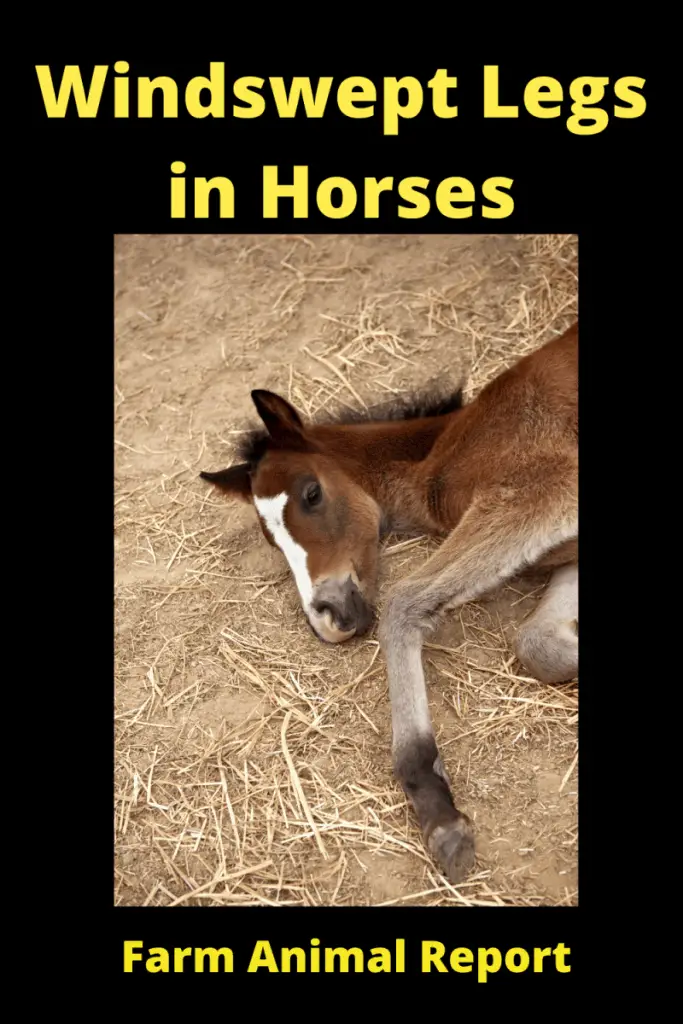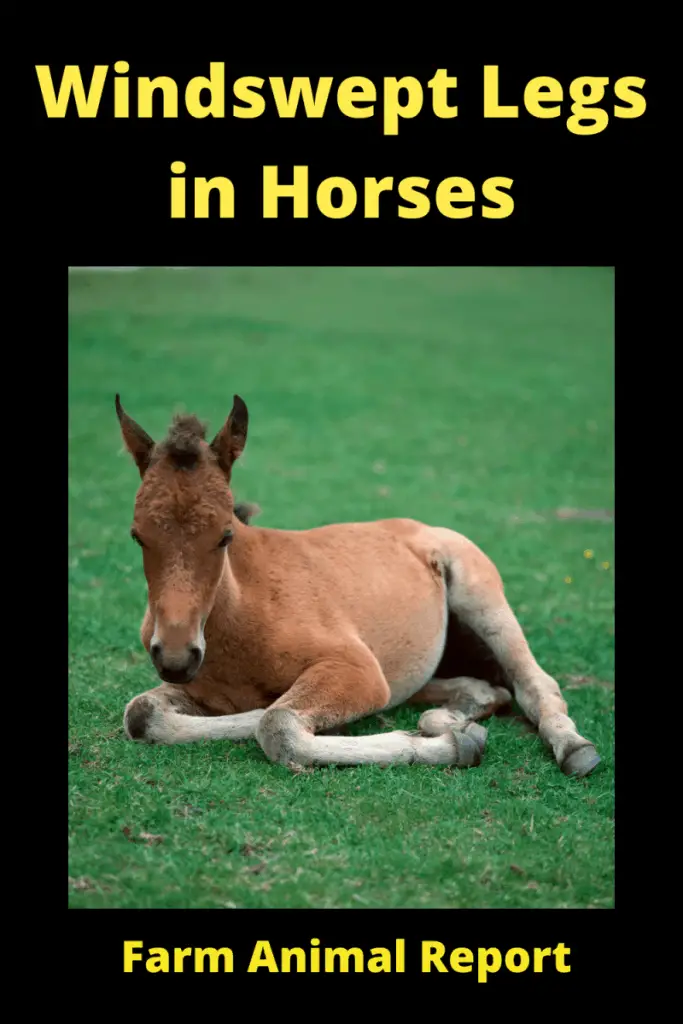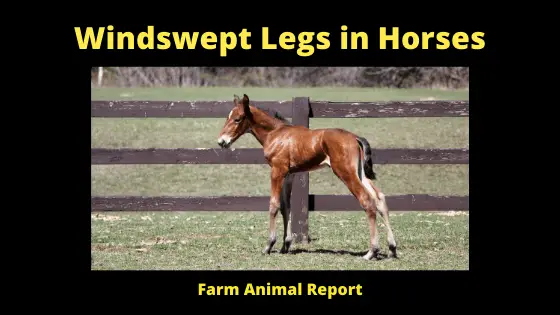Guide for Windswept Foals in Horses
Windswept Foals in Horses – Horses are very active and sharp creatures. Due to their activeness and excessive physical activities, they are more prone to limb and joint deformities/problems.
Here we will discuss windswept legs in horses with reasons and other essential details.
What are Windswept Foal Legs / Why are they Called That
Windswept legs” is basically a term that denotes an angular limb deformity in foals. The deformation causes a foal to look as though he is getting blown to one side in the wind. Angular limb deformities are not uncommon, but windswept conformation is. It affects both front legs and both hind legs when it occurs. Windswept Foals in Horses

Generally, for easy understanding windswept hind legs look as though they are both bent to one side. To get this effect, one hind leg has an outward bend, and the other hind leg is bent inward.
See Amazons Educational Resources for Horse Diseases
The bend appears to occur right below the hock, the angular joint that protrudes below the stifle, or knee, of the horse. Foals that have windswept legs are generally born with the disorder, although some may develop it shortly after birth.
What are Causes of Winswept Legs?
Basically for our ease and better clarity, windswept legs can be divided into two types
1. Congenital windswept legs (by birth)
2. Acquired windswept legs (during lifetime)
- To date, it hasn’t been clearly documented that what is the actual contributing (etiological factor) that causes this medical condition in horses.
- Note: If it is congenital, that means it is present in foal by birth, some believe it can be caused by the foal’s position in the uterus or the position of the uterus itself.
Other factors include genetics, a twin birth or insufficient nutrition during gestation may be factors. Additionally, Incomplete ossification of the tarsal or carpal bones; and/or Ligament laxity at birth with resulting soft tissue injury. Overfeeding the mare during gestation also leads to this condition in foals.
Acquired means horse got it from any trauma, injury, excessive exercise (heavy physical activity) or due to any nutritional deficiency.
Lameness is also one of the contributing factors. Lameness of one limb causes the other limb to bear more weight and becoming stressed.
NOTE: Overfeeding of nutrient dense diets can also predispose foals to get this condition. Diet must be well balanced.

NOTE: Horses have very complex nutritional needs. So, it is an important thing to keep eye on the nutrition of the horse whether he is getting all nutrients in a good balanced and sufficient amount or not.
See Our Guide – 10 Ways Horse Farmers Make Money
Diagnosis
1. Early Diagnosis / Early Treatment
It’s important to have a veterinarian examine foals right after birth. Foals’ long legs tend to look gawky and awkward with some appearance of deformity, so your veterinarian can tell you whether something is normal or abnormal about your foal’s early conformation.
2. Diagnostic Imaging
X-rays will help your veterinarian determine the extent of the deformity and likelihood of it needing medical intervention. Finally, diagnostic imaging helps a vet to exactly know the extent of the situation and to make an effective treatment strategy.
NOTE: The mild cases of windswept legs can be corrected without any veterinary assistance. But severe cases should be dealt with proper care and attention. Veterinary consultancy plays an important role in dealing with this condition.

Treatments
There are two main kinds of treatments which your vet can suggest you.
1. Conservative Treatment
.Conservative treatment can range from confinement in a stall to leaving the foal alone– the owner videotaping him over the course of a few months — to see how or if the condition progresses or resolves.
2. Surgical Treatment
A veterinary surgeon may decide to perform cuts the sheath covering the bone. No one is exactly sure why it works, but it is a relatively procedure called periosteal stripping, or periosteal transaction and elevation, whereby he minor and can be repeated without fear of overcorrecting the deformity.
Nutritional care plays an important role in combating this condition. An equine nutritionist can suggest a better diet plan for your horse. Various medications can also be suggested to cope up with this problem.
NOTE: only use vet recommended nutrient supplements and medications.
This has also been documented that the therapeutic shoeing procedure also helps in dealing with the windswept but this procedure must be done only under the supervision of a highly qualified equine expert.
Can a Steroid Be Given To the Horse?
To reduce the severity of pain and inflammation, your vet can also suggest NSAIDs. But these anti-inflammatory steroids are used with proper care and in the recommended dose in foals. As NSAIDs cause gastric ulcers in foals. So, to deal with this situation, your vet can recommend anti-ulcer drugs with NSAIDs
CONCLUSION
It is not easy to look at a horse and know whether his limb deformity is congenital or acquired, but the most important issue is to address the problem early with a defined treatment approach as outlined by your veterinarian. Rapid intervention often can turn a foal’s limb deformity around, or at least keep the degree of the horse’s abnormality to a minimum. It is essential that you, your veterinarian, and your farrier work together as a team to achieve the best possible results.
PROGNOSIS
The prognosis for ALDs is generally good if the deformity is identified and quantified early and the appropriate management instituted within the window of opportunity for that particular joint. In most instances, conservative treatment alone is generally the most successful.
RFERENCES:
Auer JA. Angular lib deformities. In: Equine Surgery. Auer AA. (ed) Philadelphia: Saunders; 1992: 940-56
Bramlage, L.R. (1994) Step osteotomy: a surgical technique for correction of permanent angular limb deformities in horses. Proc. Am. Ass. equine Practnrs. 111.
Whitfield-Cargile, C. and Watkins, J.P. (2011) Bilateral distal radial epiphysectomy and pancarpal arthrodesis for correction of complex carpal deformities in an American Miniature horse. Equine vet. Educ. 23, 381-385.
Wagner PC, Grant BD, Kaneps AJ, et al. Long-term results of desmotomy of the accessory ligament of the deep digital flexor tendon (distal check ligament) in horses. J Am Vet Med Assoc 1985;187:1351–1353.
Wright AK, Petrie L, Papich MG, et al. Effect of high-dose oxytetracycline on renal parameters in neonatal foals, in Proceedings. 38th Ann Conv Am Assoc Equin Practnr 1993; 297–298.
Horse Breeder Associations
| Horses Association | Location | Link |
|---|---|---|
| American Horse Association | United States | AHC |
| American Quarter Horse Association | United States | AQHA |
| Horse Breed Associations | America | Horse Associations |
| Directory of Horse Breed Associations | World | Directory |
| Arabian Horse Association | United States | AHA |
| Horse Breed Associations | World | Directory |


